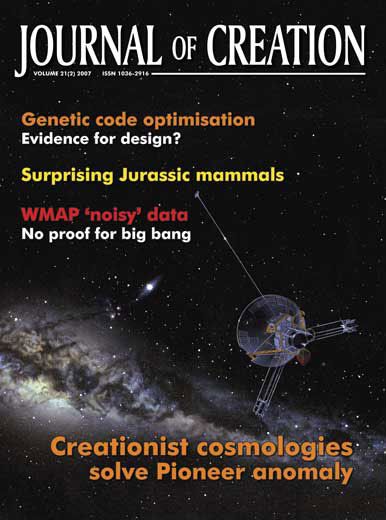Journal of Creation 21(2):3, August 2007
Browse our latest digital issue Subscribe
Origin of oxygen more complex than imagined

The major ideas in mainstream science are conveyed into the public arena through the use of metaphor—the big bang is one such, and evolution another. These metaphors frequently become entrenched, even within the scientific community, and mask the numerous problems underlying the theoretical constructs. Such theories, all based on naturalism in mainstream circles, are foundational to much scientific endeavour, providing a base for interpreting data from a wide range of disciplines. Frequently, contradictory observations do not fit well with the naturalistic interpretive framework yet there is a reluctance to question the foundational assumptions.
James Kasting, in an article published in Nature recently concerning the naturalistic origin of atmospheric oxygen,1 illustrates this quite well when he concluded that, ‘all these contradictory observations are stimulating a lot of creative thinking.’ The contradictory observations relate to the problem of how and when oxygen originated in the earth’s atmosphere.
Kasting was commenting on a letter to Nature in the same issue,2 and placing the research within historical context. He explained that
‘The [scientific] consensus for more than 30 years has been that atmospheric oxygen first reached appreciable levels around 2 billion to 2.4 billion years ago, an occasion referred to as the great oxidation event (GOE).’
Naturally, the issue of the timing and origin of the oxygenation of the atmosphere is significant because it is central to the origin of life and evolution. However, as the article points out, there are two major problems with the timing of this ‘GOE’.
First, if oxygen producing bacteria supposedly evolved some 2.7 Ga ago, why then did it take at least 300 Ma, and possibly up to 700 Ma, before oxygen comprised a significant part of the atmosphere? The significance of this time interval is that it is potentially longer than the entire timeframe of the fossil record (the Phanerozoic), and is exceedingly slow even by evolutionary standards.
The second problem is that carbonate rocks formed before and after the supposed ‘GOE’ show the same carbon isotopic signatures. The burial of organic carbon from photosynthesizing organisms should cause the ratio of 13C to 12C in carbonates to rise. This leads to a huge contradiction as explained in the article:
‘ … the source of the atmospheric oxygen—organic-carbon burial—seems to have remained constant with time, even though atmospheric oxygen levels have changed enormously.’
This problem is arguably overcome if one accepts the contention that ‘a mere 3% increase in organic-carbon burial would have been enough to trigger the GOE.’1 However, such a small increase is far too small to be detected in the geological record, as the author admits, which makes the idea geologically untestable and thus wholly hypothetical.
The article outlines various creative ways that researchers have tried to address these problems over the years, but ends with a rather forlorn conclusion: ‘The ancient atmosphere may have had a more complex evolution than we imagined.’1 In essence the author admits that within an evolutionary framework the data is contradictory, and no resolution of the contradictions is in sight, hence the need for ‘creative thinking’.
However, it is the naturalistic evolutionary framework that is the problem. Within this framework a reducing atmosphere is needed initially if the first cell is to have any possibility of arising by chance.3 But it must then change into an oxidizing atmosphere to permit the evolution of aerobic bacteria and multi-cellular life.
These problems disappear when the problem is approached from a biblical framework. There never was a great oxidation event because oxygen, at concentrations necessary for life to flourish, was present in the atmosphere during Creation week at the beginning. The geological evidence, including sulfur minerals and carbonate rocks, is explained by deposition during the early part of the global Flood.
References
- Kasting, J.F., Ups and downs of ancient oxygen, Nature 443(7112):643–645, 12 Oct. 2006. Return to text.
- Goldblatt, C., Lenton, T.M. and Watson, A.J., Bistability of atmospheric oxygen and the Great Oxidation, Nature 443(7112):683–686, 12 Oct. 2006. Return to text.
- Even with a reducing atmosphere, the naturalistic origin of life is a great unsolved mystery. See e.g. Bergman, J., Why the Miller Urey research argues against abiogenesis, Journal of Creation 18(2):28–36, 2002. Return to text.


Readers’ comments
Comments are automatically closed 14 days after publication.